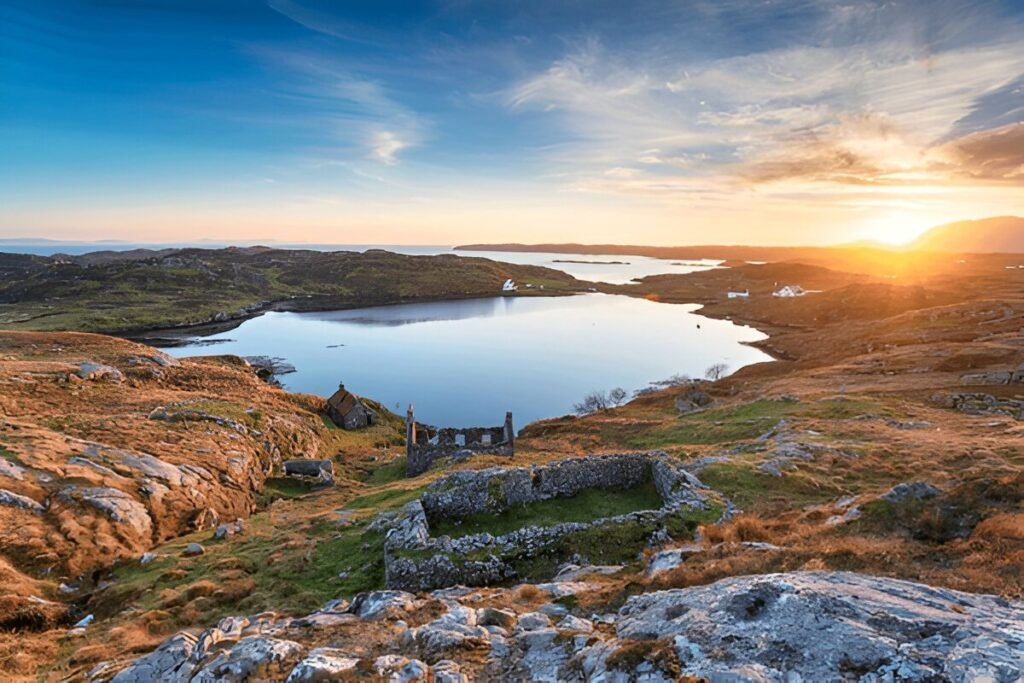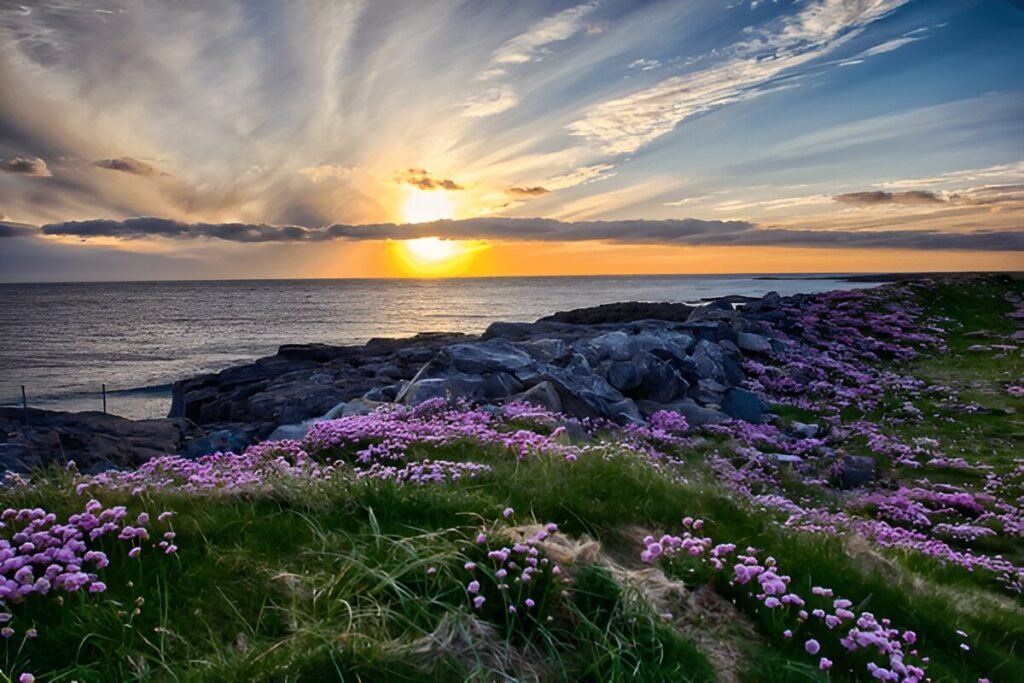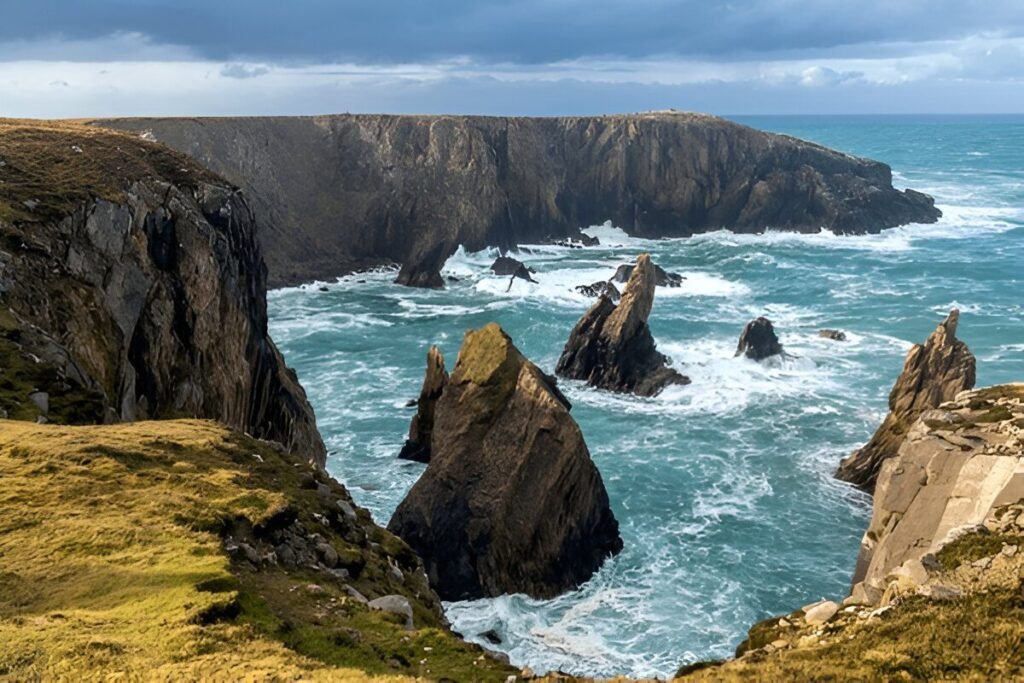Introduction
The Outer Hebrides, an archipelago off Scotland’s northwest coast, is a world apart from the hustle and bustle of modern life. These islands, stretching from Lewis and Harris in the north to Barra and Vatersay in the south, are known for their untouched landscapes, rich Gaelic heritage, and breathtaking beaches. With a history spanning thousands of years, the Outer Hebrides offer a unique blend of ancient traditions, dramatic scenery, and tranquil isolation.
Whether you’re drawn to the prehistoric standing stones, white sandy beaches, or wildlife-rich landscapes, this guide will take you through the best places to visit, how to get there, and what makes the Outer Hebrides one of Scotland’s most serene and fascinating destinations.
1. Exploring the Islands: What to See and Do

Lewis and Harris: History and Scenic Beauty
Although technically one landmass, Lewis and Harris are often considered separate islands, with Lewis in the north and Harris in the south.
Callanish Standing Stones (Isle of Lewis)
- One of Scotland’s most mysterious Neolithic sites, dating back over 5,000 years.
- Comparable to Stonehenge, these stones are believed to have astronomical or ritual significance.
- Best visited at sunrise or sunset for a truly mystical experience.
Luskentyre Beach (Isle of Harris)
- Often ranked as one of the most beautiful beaches in the world.
- Features turquoise waters and golden-white sand, reminiscent of the Caribbean.
- Perfect for walking, photography, and peaceful relaxation.
Harris Tweed Experience
- The Outer Hebrides is the birthplace of Harris Tweed, the world-famous handwoven wool fabric.
- Visit a weaving workshop to see artisans crafting tweed using traditional looms.
North Uist, Benbecula, and South Uist: A Wildlife Lover’s Paradise
These central islands of the Outer Hebrides are a haven for birdwatchers and nature enthusiasts.
RSPB Balranald Nature Reserve (North Uist)
- A prime spot to see corncrakes, eagles, and wading birds.
- Offers coastal walks with stunning views over the Atlantic.
Hebridean Way Cycling and Walking Route
- A long-distance route that stretches across 10 islands over 156 miles.
- Ideal for cycling, hiking, and spotting seals, dolphins, and otters.
Barra and Vatersay: Scotland’s Remote Gems
Barra’s Beach Airport
- One of the world’s only airports where flights land on a beach.
- A must-see attraction, especially at low tide, when the runway is revealed.
Kisimul Castle

- A medieval fortress located in the middle of Castlebay harbor.
- Accessible only by boat, this castle was historically the stronghold of Clan MacNeil.
2. Gaelic Culture and Traditions
The Outer Hebrides are the heartland of Gaelic culture, where Scottish Gaelic is still widely spoken.
Music and Festivals
- The islands are known for their traditional music scene, featuring Gaelic singing (Puirt-à-Beul), bagpipes, and folk tunes.
- Visit during the HebCelt Festival in Lewis to experience a mix of Gaelic and contemporary music.
Gaelic Language and Heritage
- Road signs across the islands are bilingual (English and Gaelic).
- Many locals speak Gaelic as their first language, making it one of the best places to experience Scotland’s linguistic heritage.
3. Getting to the Outer Hebrides

By Ferry
- Ferries operated by Caledonian MacBrayne (CalMac) connect the Outer Hebrides to the mainland.
- Main routes:
- Ullapool to Stornoway (Lewis) – the fastest way to reach the northern islands.
- Uig (Skye) to Tarbert (Harris) – a scenic route from the Isle of Skye.
- Oban to Castlebay (Barra) – ideal for exploring the southern islands.
By Air
- Flights from Glasgow, Edinburgh, and Inverness serve Stornoway (Lewis), Benbecula, and Barra.
- Barra’s beach landing is a unique experience, but flights are dependent on tides.
4. Best Time to Visit

Spring and Summer (April–August)
- Best weather, with long daylight hours and minimal rainfall.
- Ideal for beach visits, hiking, and wildlife spotting.
- Festivals like HebCelt and local agricultural shows take place.
Autumn and Winter (September–March)
- Quieter season with fewer tourists.
- Excellent for storm-watching and experiencing the Northern Lights.
- Some ferry and flight schedules may be limited.
5. Food and Drink in the Outer Hebrides
The Outer Hebrides are known for their fresh seafood, local meats, and traditional dishes.
Must-Try Foods
- Stornoway Black Pudding – A world-famous delicacy, made using a traditional recipe.
- Hebridean Salmon – Fresh, locally sourced, and served in many restaurants.
- Scallops and Lobster – Often hand-dived and cooked simply to highlight their natural flavors.
Where to Eat
- The Anchorage Restaurant (Leverburgh, Harris) – Known for its seafood dishes and harbor views.
- Uig Sands Restaurant (Lewis) – Offers modern Scottish cuisine with stunning beachside views.
- Café Kisimul (Barra) – A unique mix of Scottish and Indian flavors, famous for its curried seafood dishes.
Conclusion
The Outer Hebrides offer an unforgettable escape into Scotland’s most serene landscapes, rich with history, culture, and natural beauty. Whether you’re standing among the Callanish Stones, exploring hidden beaches, or cycling across windswept islands, these remote isles provide a sense of tranquility like no other.
For travelers seeking a unique, off-the-beaten-path adventure, the Outer Hebrides are truly Scotland’s islands of serenity.












